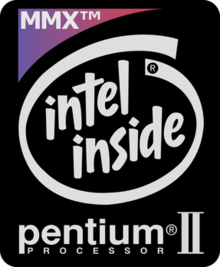 Original Pentium II MMX case badge | |
| General information | |
|---|---|
| Launched | May 7, 1997 |
| Discontinued | December 26, 2003[1] |
| Marketed by | Intel |
| Designed by | Intel |
| Common manufacturer |
|
| CPUID code | Klamath: 80522 Deschutes and Tonga: 80523 Dixon: 80524 |
| Performance | |
| Max. CPU clock rate | 233 MHz to 450 MHz |
| FSB speeds | 66 MT/s to 100 MT/s |
| Cache | |
| L1 cache | 32 KB (16 KB data + 16 KB instructions) |
| L2 cache | 256–512 KB |
| Architecture and classification | |
| Technology node | 350 nm to 180 nm |
| Microarchitecture | P6 |
| Instruction set | IA-32 |
| Extensions | |
| Physical specifications | |
| Transistors |
|
| Cores |
|
| Sockets |
|
| Products, models, variants | |
| Core names |
|
| History | |
| Predecessors | Pentium, Pentium Pro, Pentium MMX |
| Successors | Pentium III (SSE successor), Celeron, Pentium 4 (SSE2 successor) |
| Support status | |
| Unsupported | |

The Pentium II[2] brand refers to Intel's sixth-generation microarchitecture ("P6") and x86-compatible microprocessors introduced on May 7, 1997. Containing 7.5 million transistors (27.4 million in the case of the mobile Dixon with 256 KB on-die L2 cache), the Pentium II featured an improved version of the first P6-generation core of the Pentium Pro, which contained 5.5 million transistors. However, its L2 cache subsystem was a downgrade when compared to the Pentium Pro's.
In 1998, Intel stratified the Pentium II family by releasing the Pentium II-based Celeron line of processors for low-end computers and the Pentium II Xeon line for servers and workstations. The Celeron was characterized by a reduced or omitted (in some cases present but disabled) on-die full-speed L2 cache and a 66 MT/s FSB. The Xeon was characterized by a range of full-speed L2 cache (from 512 KB to 2048 KB), a 100 MT/s FSB, a different physical interface (Slot 2), and support for symmetric multiprocessing.
In February 1999, the Pentium II was replaced by the nearly identical Pentium III, which only added the then-new SSE instruction set. However, the older family would continue to be produced until June 2001 for desktop units,[3] September 2001 for mobile units,[4] and the end of 2003 for embedded devices.[1]
- ^ a b "Product Change Notification #102659-02" (PDF). Intel. August 14, 2002. Archived from the original (PDF) on March 20, 2003. Retrieved October 14, 2019.
- ^ "Microprocessor Hall of Fame". Intel. Archived from the original on July 6, 2007. Retrieved August 11, 2007.
- ^ "Product Change Notification #896" (PDF). Intel. January 14, 2000. Archived from the original (PDF) on September 30, 2000. Retrieved October 14, 2019.
- ^ "Product Change Notification #954" (PDF). Intel. March 13, 2000. Archived from the original (PDF) on August 15, 2000. Retrieved October 14, 2019.